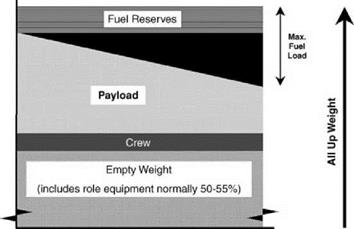Performance
7.1 Introduction
The preceding chapters have been mostly concerned with establishing the aerodynamic characteristics of the helicopter main rotor. We turn now to considerations of the helicopter as a total vehicle. The assessment of helicopter performance, like that of a fixed-wing aircraft, is at bottom a matter of comparing the power required with that available, in order to determine whether a particular flight task is feasible. The number of different performance calculations that can be made for a particular aircraft is of course unlimited, but aircraft specification sets the scene in allowing meaningful limits to be prescribed. A typical specification for a new or updated helicopter might contain the following requirements, exclusive of emergency operations such as personnel rescue and life saving:
• Prescribed missions, such as a hover role, a payload/range task or a patrol/loiter task. More than one are likely to be called for. A mission specification leads to a weight determination for payload plus fuel and thence to an all-up weight, in the standard fashion illustrated in Figure 7.1.
• Some specific atmosphere-related requirements, for example the ability to perform the mission at standard (ISA) temperature plus, say, 15°; the ability to perform a reduced mission at altitude; the ability to fly at a particular cruise speed.
• Specified safety requirements to allow for an engine failure.
• Specified environmental operating conditions, such as to and from ships or oil rigs.
• Prescribed dimensional constraints for stowage, air portability and so on.
• Possibly a prescribed power plant.
Calculations at the flexible design stage are only a beginning; as a design matures, more will be needed to check estimates against actual performance, find ways out of unexpected difficulties, or enhance achievement in line with fresh objectives. (One is effectively zeroing in on the details.)
Generally, in a calculation of achievable or required performance, the principal characteristics to be evaluated are:
1. Power needed in hover.
2. Power needed in forward flight.
Basic Helicopter Aerodynamics, Third Edition. John Seddon and Simon Newman. © 2011 John Wiley & Sons, Ltd. Published 2011 by John Wiley & Sons, Ltd.
|
Figure 7.1 Determination of all-up weight for prescribed mission |
3. Envelope of thrust limitations imposed by retreating-blade stall and advancing-blade
compressibility drag rise.
The following sections concentrate on these aspects, using simple analytical formulae, mostly already derived. Item 3 must always be kept under review because the flight envelope so defined often lies inside the power limits and is thus the determining factor on level flight speed and manoeuvring capability.
A brief descriptive section is included on more accurate performance estimation using numerical methods. The chapter concludes with three numerical examples: the first concerns a practical achievement from advanced aerodynamics; the others are hypothetical, relating to directions in which advanced aerodynamics may lead in the future.












